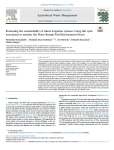Batoukhteh F., Darzi-Naftchali A., Motevali A., Karandish F., Berger M. (2025). Evaluating the sustainability of wheat irrigation systems: using life cycle assessment to monitor the Water-Energy-Food-Environment Nexus. Agricultural Water Management, 30/06/2025, vol. 315, p. 109521.
https://doi.org/10.1016/j.agwat.2025.109521
https://doi.org/10.1016/j.agwat.2025.109521
| Titre : | Evaluating the sustainability of wheat irrigation systems: using life cycle assessment to monitor the Water-Energy-Food-Environment Nexus (2025) |
| Auteurs : | F. Batoukhteh ; A. Darzi-Naftchali ; A. Motevali ; F. Karandish ; M. Berger |
| Type de document : | Article |
| Dans : | Agricultural Water Management (vol. 315, June 2025) |
| Article en page(s) : | p. 109521 |
| Langues : | Anglais |
| Langues du résumé : | Anglais |
| Catégories : |
Catégories principales 07 - ENVIRONNEMENT ; 7.3 - Eau. Gestion de l'EauThésaurus IAMM GESTION DES EAUX ; METHODE D'IRRIGATION ; IRRIGATION ; DURABILITE ; ANALYSE DU CYCLE DE VIE ; RESSOURCE EN EAU ; RESSOURCE ENERGETIQUE ; RESSOURCE ALIMENTAIRE |
| Résumé : | This pioneering study employs the Water-Energy-Food-Environment Nexus (WEFEN) framework to evaluate the sustainability of various wheat irrigation systems—furrow (FI), sprinkler (SI), and drip irrigation (DI)—by integrating renewable energy (solar PV and small-scale wind turbines) and life cycle assessment (LCA). Field data were collected from representative farms across five climates: hyper-arid, arid, semi-arid, dry-sub-humid, and humid. A structured questionnaire was designed to obtain information on cropping areas, input consumption, field management practices, crop yield, costs, and income. Renewable energy scenarios, including 100 % renewables (RE100 %) and a 50 % grid mix (RE50 %), were modeled using Homer Pro software, and environmental impacts (EI) were assessed via LCA. Transitioning from FI to DI significantly enhanced both water and energy productivity, up to 107 % and 60 %, respectively, in hyper-arid and arid climates. The incorporation of renewable energy further improved energy productivity by 33 % and reduced EI by up to 61 %, with the most pronounced benefits observed in arid regions. Key EI hotspots identified across all climates and irrigation systems included electricity, chemical fertilizers, and diesel fuel. The WEFEN index ranked DI highest (0.75), followed by SI (0.53) and FI (0.45). These results offer critical insights for enhancing resource efficiency, especially in regions facing water and energy scarcity, and provide actionable strategies for reducing environmental burdens. The findings of this research may significantly advance several global Sustainable Development Goals, particularly those focused on Zero Hunger, Affordable and Clean Energy, and Climate Action. |
| Cote : | En ligne |
| URL / DOI : | https://doi.org/10.1016/j.agwat.2025.109521 |







